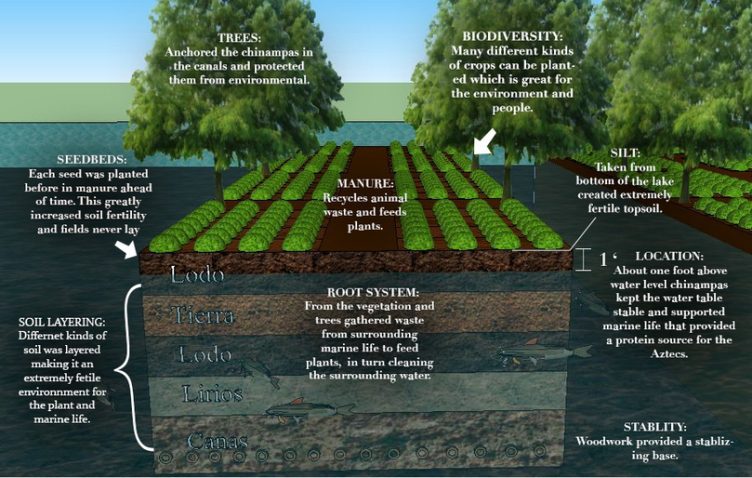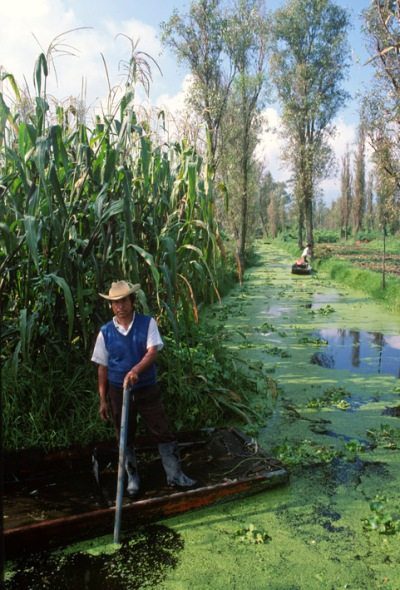They’ve been there since long before the day Cortes got his first glimpse the Aztec Empire in 1519. The chinampas have come full circle, from feeding the city’s population to ruin, and finally, restoration brings urban farming and local food back to Mexico City. It’s been a long, bumpy ride. The worst of which appears to have taken place in more recent years.
According to historical accounts, the beauty of the huge Aztec city with a population of 5-6 million took the conquistadors’ breath away. These first to arrive later wrote that its breadth and shimmering canals made the glory of Venice pale. The invaders marveled at the use of the valley’s five shallow lakes like roads. The masses of highly productive “floating gardens” or chinampas totally amazed them. But not for long. Cortes would soon drain the water away, leaving a vast arid space in its place.
Many proclaim that the chinampas were early hydroponic systems, but this assumption isn’t correct. The base of a newly constructed chinampa only needed to float from shore to the designated installation spot. Once in place, the Aztecs anchored them to the lake floor and built the substrate in layers on top. It was really more of a structural foundation, the base of a basket to hold man-made islands in uniform shapes. Island farm plots that fully integrated natural environment benefits without depleting them. As agricultural systems go, the chinampa is highly sustainable farming with added perks, like the fish that lived in the canals that offered both fertile mud for next year’s crops and a fine fillet for the dinner plate.

True chinampas construction, bottom to top: bamboo canes and logs, water hyacinths (vegetation), mud, soil, mud, manure. (University of Texas, Arlington)
Water-loving willow trees planted on each corner permanently anchored the chinampas in place. A wattle soil erosion barrier held in place by posts and tree roots prevents plants and production soil from washing back into the water. It looks like they discovered living root systems outlasted wattle seawalls at some point, because today a coppiced tree hedge border many of the islands.
Between the regular rich, black muck top dressing and the climate, they were able to grow a succession of 5-6 crops a year. Their practice of reclaiming nutrient run-off and wildlife deposits from the canal floors offers a perpetually renewable, local fertilizer source. To which the chinampas add plant waste and manure to continually build the soil.

Some very happy corn (Adalberto MX).
An ingenious growing system designed over 1000 years ago, though its magic totally escaped the reasoning of the Spanish. The narrow strips of land surrounded by standing water can’t help to wick up consistent moisture. It’s really taking full advantage of Nature’s capillary system that draws available moisture up through soil as plants need water. They started seedlings in tightly planted manure-enriched nursery beds, transplanting into rows and patches with good plant spacing. The Aztecs also controlled rising water levels during the rainy season to prevent crop destruction using a sophisticated series of canals.
In 1987 UNESCO made the Xochimilco chinampas a U.N. World Heritage Site. The Mexican government converted the area into a huge park, and work began to reclaim and restore the canals and growing fields. But the challenge was huge. Though a handful of farmers still cultivated chinampa plots, the once impressive agricultural system was a mess. Overrun by weeds, free ranging cattle, literally sucked dry by development and urban sprawl. The little water that remained was extremely polluted, filled with garbage and teeming with foreign fish.
Despite the efforts of a dozen government agencies, one local biologist told the Washington Post in early 2012 the place was dying. The reporter quotes Gloria Valek, a Xochimilco historian, as saying saving it might be impossible.
““Things have been bad for a long time. But now we fear that the destruction is accelerating, that within our lifetimes, this very special place will no longer exist,” Zambrano said. “It will just be a few dirty canals for the tourists and will mean nothing.”” — Washington Post
Four years later…
The migrating birds have returned to this overwintering grounds. The almost extinct Axolotl salamander, found only in the waters of Xochimilco, is bouncing back. And the chinampas are once again a place for growing food and flowers in the metropolis of Mexico City. There are three distinctly different parts to Xochimilco. The touristy area at Nativitas where good food and beer flow freely. The flower fields in San Gregorio where many pesticides and synthetic fertilizers are used. And the urban farming side in the canals of Cuemanco.

Urban Farming Chinampas in Modern Xochimilco (Leaves of Green)
Cuemanco chinampas grow food crops using only organic fertilization practices. Like their ancestors, they too rely on the nutrient-rich canal soil and composted crop debris to support the plants they grow. It’s a method that is highly productive, and the newly emerging urban farming space has a champion in De la Chinampa, owned by Ricardo Rodriguez, who along with his biologist wife, Laura, have been involved in rescuing Xochimilco’s chinampas for local food production for years.
Through his company, Ricardo has been working on connecting the growers with an awakening market. Both organic food and locally grown food is very new to modern-day Mexico City. Until very recently, only a couple elite restaurants in the city sourced local produce for the menu. Now, however, there are several. Organic produce is showing up in grocery stores, and a sort chinampas co-op CSA setup exists on De la Chinampa’s website. They deliver orders for fruits and vegetables, dairy products, eggs and more 3 days a week.
Rodriguez says that over 26,000 hectares of Xochimilco’s land could be turned into agricultural space. Almost half of that land is in the Xochimilco Ecological Reserve. But before such an achievement can be seriously considered, the demand for locally grown produce must be built. This is what his company is all about. And as we’ve seen in other large cities, along with urban farms come new jobs and a fresh economy.
A hugely interesting story, both the ancient history and the more modern chapters. There’s a whole lot more to know, and tons of recent photos too. Rodriguez conducts Chinampas Tours by boat complete with fresh salads, local cuisine, and the ingredients were all produced by the chinampas or brought in from other sources nearby. Avocados, for instance, don’t thrive in the moist soils of the chinampas. Those have to come in from the mountainsides around the valley.
Start your tour without leaving wherever you are at the moment through the photos taken by recent visitors. And learn more about the ups and downs and ins and outs of urban farming chinampas through these links below. It’s anything but boring, and the produce is beautiful!
More Info & Sources:
- Washington Post (2012)
- New York Times (1993)
- Ancient Origins
- Adalberto MX
- The Mija Chronicles
- Binny’s Kitchen
- Zomppa
- De la Chinampa
- Smithsonian (news source)
- Wikipedia